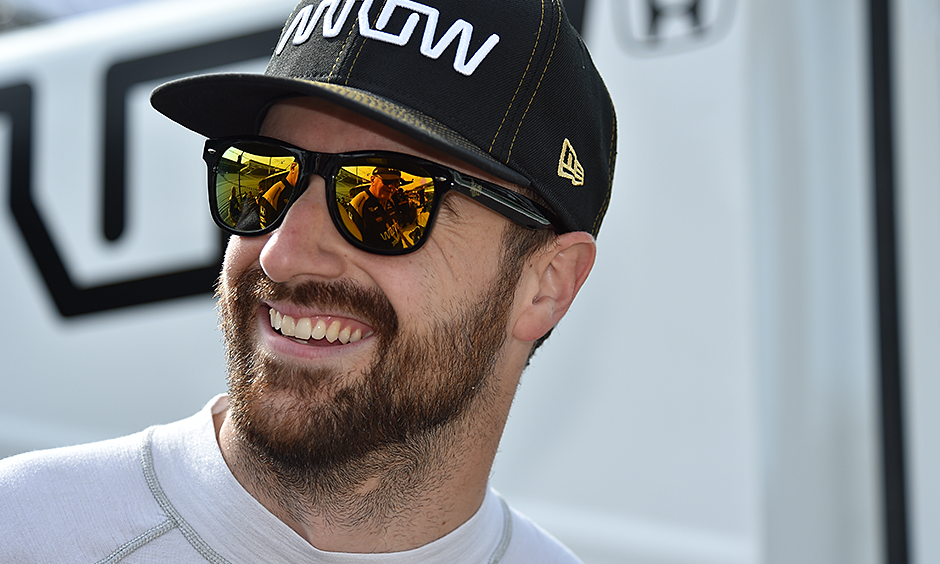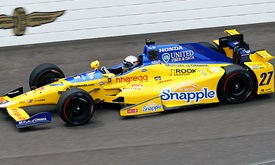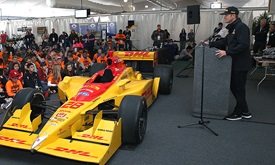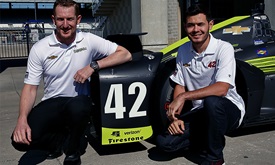Hinchcliffe back on IMS oval and back to his old self
MAY 17, 2016
At the end of a long opening day, James Hinchcliffe put on a happy face.
He scribbled a series of autographs for appreciative fans who congregated outside the Schmidt Peterson Motorsports garage in the southwest corner of Gasoline Alley. He even smiled for a few “selfie” cellular phone pictures with a throng of admirers.
So how was Monday’s first day of practice for the 100th Indianapolis 500 presented by PennGrade Motor Oil?
“Not very good,” Hinchcliffe said, once inside the garage, “but that’s Indy for you.”
His No. 5 Arrow Schmidt Peterson Motorsports Honda ranked 29th on the speed chart — he knows this and mentions it — but then again, the 29-year-old Hinchcliffe can’t forget the big-picture perspective that this won’t qualify as the end of the world.
“Every day you walk out of this place,” he said, “it’s a good day.”
That’s because Hinchcliffe didn’t walk out of the Indianapolis Motor Speedway last year. On May 18, a day after he had qualified 24th for the Indy 500, Hinchcliffe suffered life-threatening injuries in a Turn 3 crash. The right front suspension of his car broke, causing a steel rod to impale him through his right thigh and into his left leg.
He lost massive amounts of blood and although semi-conscious for several minutes, he suffered a concussion and doesn’t remember what happened. The quick response and immediate treatment by the Verizon IndyCar Series’ Holmatro Safety Team and medical personnel saved his life.
Four months later, miraculously, Hinchcliffe was back in a race car.
Two days away from the anniversary of that crash, Hinchcliffe is in the best shape of his life, according to team owner Sam Schmidt.
And the “Mayor of Hinchtown,” his fantasy online community, hasn’t lost his sense of humor. “Hinch” has worn white “I’m Fine” T-shirts with a fake blood stain on the side. His Zionsville roommate, Conor Daly, says it’s customary for Hinchcliffe to crack jokes about what happened.
“Everyone knows what happened,” said Daly, who drove for Hinchcliffe after the crash. “I was the first one at the hospital. He doesn’t mind talking about it. We joke about it all the time. That’s the way ‘Hinch’ is.”
It helps that Hinchcliffe doesn’t recall what happened. Sure, there was doubt and fear at first. That’s human nature. But he passed that test in September, when he got back into a car. In April, he drove a car at IMS, so that psychological hurdle was handled without issue.
“It’s over and done with, man,” Hinchcliffe said. “It’s in the past. Obviously it’s something I won’t forget, but it’s not something I have to remember every day.
“I don’t remember it, so it’s not like I had this fear of going through Turn 3. For me, the big day was just getting back into the car in September. After that, everything was easy.”
Schmidt, paralyzed by a 2000 practice crash, knows as much about coping with the dangerous side of motorsports as anyone. The 51-year-old quadriplegic scoots around racetracks in a mechanized wheelchair.
“Frankly, I think as far as the team and our perspective, it’s been out of our mind for some time,” Schmidt said. “I don’t know for him personally if it’s something you can ever completely block out, something that radical and traumatic. But at the same time, when we started testing in September at Road America, when we were done, all of the sort of ‘get well soon’ propaganda was gone.
“It’s a new season. We’re here to win the race. As a team, I would say we’re looking forward, not backward.”
Hinchcliffe, eager to make his fifth Indy 500 start on May 29, has qualified well without the results he’d prefer. He made his debut at IMS in 2011, qualifying 13th and finishing 29th for Newman/Haas Racing. In three years with Andretti Autosport, he qualified second, ninth and second but finished sixth, 21st and 28th.
It’s fair to say he’s more than familiar with the challenge this track and race present.
“It wasn’t an unproductive day, by any stretch, but this week always has a way of throwing you some curveballs,” he said. “It’s easy to get caught up in things that happen during practice week, but we’re not doing that. We didn’t go running around in traffic like a bunch of guys, so we’re not too despondent with 29th place or wherever we are. It looks bad on paper, but it’s actually not as bad as it looks.”
In other words, he’s convinced other drivers posted faster laps as a result of tows, whereas Hinchcliffe’s speeds were more unassisted. His fastest speed was 220.715 mph, well off the day’s leader, Marco Andretti, at 228.978 mph.
In perhaps another symbolic gesture of putting the past behind him, Hinchcliffe traded the helmet he was wearing in the crash to Daly for a new one his roomie had designed for a race in Toronto, a helmet that included a caricature of Hinchcliffe and Canadian maple leafs.
“I told him, ‘I’m taking that helmet because you can’t wear it anywhere else. It was only for Toronto,’” Hinchcliffe said. “I decided to give him that (helmet) that I was wearing when the job came open and he had the opportunity to get into the car.”
Added Daly, “It seemed like a fair trade.”
These days, it’s as if last May never happened. Daly said he can’t see a change, that “Hinch” just seems happy to be back.
“No complaints, man,” Hinchcliffe said. “I’m still here.
“Same guy, a little smarter,” he said, then after a pause added, “maybe.”



















